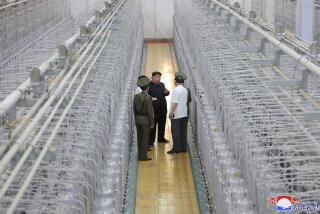World Perspective : Nuclear Police
- Share via
Inspectors from the International Atomic Energy Agency have been trying for months to take samples from the nuclear fuel rods in North Korea’s five-megawatt reactor at Yongbyon, but they have been blocked by the Pyongyang government. What are they looking for--and why? The Times asked David Kay, a former IAEA inspector now with Science Applications International Corp. in McLean, Va., to detail the process. Here is his description of how the IAEA inspectors do their jobs:
EXHIBIT A: The Fuel Rods
Fuel rods contain the uranium that produces a nuclear chain reaction. This chain reaction--triggered when control rods are partially withdrawn--causes a tremendous amount of heat, which turns the turbines that generate electricity. It also produces plutonium. By monitoring the fuel rods, inspectors can determine if the weapons-grade material is being diverted.
EXHIBIT B: Reprocessing Tanks
The areas where nuclear technicians reprocess fuel rods provide clues to whether plutonium is possibly being diverted to make bombs. Here is how plutonium is stripped from fuel rods:
1. Technicians shear the ends off the rods with a rotary saw
2. Rods are placed in a vat of nitric acid to dissolve the aluminum coatings
3. Rods are then dunked in a second set of chemicals to retrieve plutonium.
What the inspectors do. . .
On the initial visit: Take swabs of soil samples and of dust gathered on plant machinery to measure their radioactivity.
Install videotape cameras at the site.
Place special seals on key pieces of equipment--such as those involved in reprocessing spent fuel rods--to show whether they have been tampered with between inspections.
On Periodic return trips: Change the videotape on the cameras and replace the batteries.
Check to see whether the seals have been broken.
Measure the radioactivity both outside and inside the reprocessing building to see whether there are signs that more of the spent reactor fuel has been converted to weapons-grade material plutonium.
When a reactor has been shut down for refueling: Check the spent fuel rods being removed from the reactor to determine whether the North Koreans have been reprocessing more spent fuel than the 40 rods that they initially claimed. The inspectors do this by picking out about 300 of the 8,000 used rod. By measuring how much plutonium has accumulated in various rods, the scientists can tell how long they have been in the reactor. They can then determine whether the Koreans have removed more spent fuel than they have acknowledged.
Check nuclear waste sites to analyze their contents. This is standard procedure, but the North Korean government has forbidden the IAEA from visiting its nuclear dumps.
Return samples to Vienna for more thorough analysis.
The U.S.--North Korean Dispute and How It Grew
1985: North Korea signs the nuclear Non-Proliferation Treaty. In the process, it agrees to list all its nuclear facilities and to allow inspectors from the International Atomic Energy Agency to visit its reactor and radioactive waste sites to verify the information.
1992: Almost seven years after North Korea joined the treaty, the Vienna-based IAEA finally conducts a preliminary inspection visit, and finds a major discrepancy: Although North Korea claimed that it had acquired a small amount of plutonium from a single reprocessing of spent fuel rods from its reactor, an analysis shows that it actually reprocessed used fuel rods several times, suggesting that it had been conducting a much larger operation than it was admitting--possibly with plans to manufacture nuclear weapons. North Koreans repeatedly balk at further inspections.
1994: The Clinton Administration, alarmed by the prospect that the North Koreans might be building a nuclear arsenal, demands additional IAEA inspections--ultimately in vain. North Korea surprises the West by announcing in late April that it is shutting down its reactor at Yongbyon immediately and removing the spent fuel rods, jeopardizing the IAEA’s ability to tell whether additional plutonium has been diverted.
MAY, 1994: The IAEA tries to extract samples from the spent fuel rods, but is blocked by North Korea from taking the measurements that it wants. The United States, South Korea and Japan begin pressing for imposition of U.N. sanctions as punishment.
Other Nations Under Close Watch
Iran
Iraq
Libya
Syria
Source: David Kay, Science Applications International Corp., McGraw Hill Encyclopedia of Science and Technology, The Macmillan Visual Dictionary; Researched by ART PINE / Los Angeles Times
More to Read
Sign up for Essential California
The most important California stories and recommendations in your inbox every morning.
You may occasionally receive promotional content from the Los Angeles Times.













